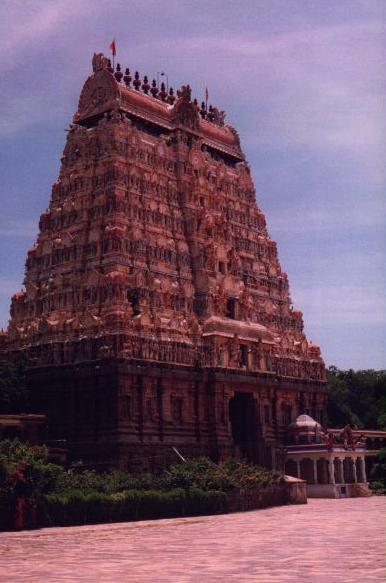The origins of the vast
Nataraja temple complex at Chidambaram are buried in antiquity. Literature talks of a
tradition of Shiva (Nataraja) worship in existence even as early as the
Sangam period (very early on in the Christian era).

The Tamil Saivite Saints of the 2nd half of
the 1st millennium CE have sung its fame when an established worship tradition was in
place. Each of the four most revered Saivite Saints (Appar, Sundarar,
Sambandar and Manikkavacakar) has worshipped at Chidambaram, and the bulk of
Manikkavacakar's work is in praise of Shiva at Chidambaram. Accordingly, their images are
placed in the temple entrances corresponding to their points of entry into the temple.
(Sambandar - South, Appar - West, Sundarar - North and Manikkavacakar - East).
The Alwar Poems of the Naalayira Divya Prabandam
sing the glory of Vishnu, whose image is also housed in this temple, and his shrine is
referred to as 'Tiruchitrakootam'.
Aadi Sankara
is said to have presented a Spatika Lingam which is still under worship in this temple.
The later Chola
Kings (Aditya I and Parantaka I) adorned the roof of the shrine with gold (circa
10th century CE), and the other Chola Kings treated
Nataraja as their guardian deity and made several endowments to the temple and expanded
and fortified the structure as temple inscriptions (seen even today) testify.
Sekkizhaar's
Periya Puranam, describing poetically the life of the Saivite Saints (63 in
number) was composed in the 1000 pillared hall, and was expounded by the author himself in
the presence of the Chola emperor Kulottunga II, who had comissioned the
work, amidts great festivity and fanfare.
The Pandya
Kings who followed them, and the later Vijayanagar rulers made
several endowments to the temple.
There is a stone image
of Krishnadevaraya in the North Gopura which he is said to have erected.
In the wars of the 18th
century, this temple was used as a fort, especially when the British General Sir
Eyre Coote unsuccesfully tried to capture it from the Mysore Kings. During this
period, the images of Nataraja and Sivakamasundari were housed in the Tiruvarur
Tyagaraja temple for safety.
Muthuswamy
Deekshitar, one of the foremost composers in the Karnatic Music tradition sings
the glory of this temple in his kriti 'Ananda Natana Prakasam'.
Apart from the works
mentioned above, several other literary works in Sanskrit and in Tamil speak of the glory
of Chidambaram, which has been a prominent center of worship for several centuries.
